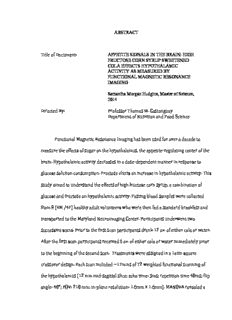
APPETITE SIGNALS IN THE BRAIN PDF
Preview APPETITE SIGNALS IN THE BRAIN
ABSTRACT Title of Document: APPETITE SIGNALS IN THE BRAIN: HIGH FRUCTOSE CORN SYRUP SWEETENED COLA EFFECTS HYPOTHALAMIC ACTIVITY AS MEASURED BY FUNCTIONAL MAGNETIC RESONANCE IMAGING Samantha Morgan Hudgins, Master of Science, 2014 Directed By: Professor Thomas W. Castonguay Department of Nutrition and Food Science Functional Magnetic Resonance Imaging has been used for over a decade to measure the effects of sugar on the hypothalamus, the appetite-‐regulating center of the brain. Hypothalamic activity decreases in a dose-‐dependent manner in response to glucose solution consumption. Fructose elicits an increase in hypothalamic activity. This study aimed to understand the effects of high fructose corn syrup, a combination of glucose and fructose on hypothalamic activity. Fasting blood samples were collected from 8 (4M /4F) healthy adult volunteers who were then fed a standard breakfast and transported to the Maryland Neuroimaging Center. Participants underwent two successive scans. Prior to the first scan participants drank 12 oz. of either cola or water. After the first scan participants received 6 oz. of either cola or water immediately prior to the beginning of the second scan. Treatments were assigned in a Latin square crossover design. Each scan included ~17mins of T2 weighted functional scanning of the hypothalamus (12 mm mid-‐sagittal slice; echo time: 5ms; repetition time 40ms; flip angle: 40°; FOV: 210 mm; in-‐plane resolution: 1.6mm X 1.6mm). MANOVA revealed a statistically significant three-‐way interaction between time, volume and treatment when the model was weighted with either fasting insulin (p<0.0001) or fasting triglycerides (p=0.023). Gender also significantly interacted with time, volume and treatment (p=0.008). Further, age was negatively correlated with overall average hypothalamic signal intensity with volume as well with treatments. Both demographics and metabolites strongly influence hypothalamic response, making it difficult to determine the specific effects of high fructose corn syrup sweetened cola on appetite signals in the hypothalamus. APPETITE SIGNALS IN THE BRAIN: HIGH FRUTOSE CORN SYRUP SWEETENED COLA EFFECTS HYPOTHALAMIC ACTIVITY AS MEASURE BY FUNCTIONAL MAGNETIC RESONANCE IMAGING By Samantha Morgan Hudgins Thesis submitted to the Faculty of the Graduate School of the University of Maryland, College Park, in partial fulfillment of the requirements for the degree of Master of Science 2014 Advisory Committee: Professor Thomas W. Castonguay, Chair Dr. David Baer Dr. Donald J. Bolger ©Copyright by Samantha Morgan Hudgins 2014 Acknowledgements Thank you to my family for all of your support. In dedication to my father, whose unconditional love and support has helped me remember who I really am and to strive to be that person without wavering. And to my beautiful daughter Blair, without her I would be lost. To Dr. C- Thank you for being a wonderful mentor and giving me so many opportunities. You are not my rate limiting step. ii Table of Contents Acknowledgements……………………………………………………………….……………………… ii Table of Contents …………………………………………………………………………….…………. iii List of Figures …………………………………………………………………………………………. iv List of Tables ……………………………………………………………………………………………. v List of Abbreviations …………………………………………………………………………………… vi Chapter I: Literature Review …………………………………………………………………………... 1 Introduction ……………………………………………………………………………………….…….. 2 Obesity epidemic ………………………………………………………………………………... 3 Recent controversy about fructose and high fructose corn syrup ………………………………. 3 Effect of single nutrients on gene expression ………………………………………………….. 4 Effect of fructose in particular …………………………………………………………………. 4 Glucose affects hypothalamic signaling ……………………………………………………………….. 5 FMRI …………………………………………………………………………………………… 6 Applying fMRI to the study of the effects of sugars on the hypothalamus ……………………………. 7 Specificity: Glucose vs. Fructose ………………………………………………………………. 9 Taste and Reward ………………………………………………………………………………………. 11 Reward pathway ………………………………………………………………………………………... 11 Gustatory (taste) pathway ……………………………………………………………………………… 11 Reward and calorie content …………………………………………………………………………….. 12 Taste and reward in obese vs. non-obese ………………………………………………………………. 13 Obesity and type II diabetes ……………………………………………………………………. 14 Conclusions …………………………………………………………………………………………….. 15 Chapter II: Appetite Signals in the Brain: High Fructose Corn Syrup Sweetened Cola Effects Hypothalamic Activity as Measured by fMRI …………………………………………………………. 16 Introduction …………………………………………………………………………………………….. 17 Materials and Methods …………………………………………………………………………………. 19 Results ………………………………………………………………………………………………….. 22 Subjects…………………………………………………………………………………………. 22 Hypothalamic activity responds to dose ……………………………………………………….. 23 Insulin and triglycerides affect hypothalamic response ………………………………………... 24 Age and gender predict hypothalamic response ……………………………………………….. 25 Discussion ……………………………………………………………………………………………… 25 Literature Cited ………………………………………………………………………………………… 40 iii List of Figures Figure 1. Fructose Consumption 1961-2000 …………………..………………………………………. 30 Figure 2. fMRI 3-Tesla Magnet ………………………………………………………………………... 31 Figure 3. BOLD Signal ……………………………………………………………………………….... 32 Figure 4. Dose Response in Hypothalamus ……………………………………………………………. 33 Figure 5. Four-Way Interaction Gender*Time*Treatment*Volume …………………………………... 34 Figure 6. Increased Age Associated with Increased Hypothalamic Response ……………………….... 35 iv List of Tables Table 1. Nutrient Analysis of Standardized Breakfast …………………………………………………. 36 Table 2. Subject Data …………………………………………………………………………………... 37 Table 3. Fasting Metabolites are Predictive of Hypothalamic Response …………………………….... 38 Table 4. Hypothalamic Response Increases with Age …………………………………………………. 39 v List of Abbreviations 11β HSD1…………………………………………………...……..11β -hydroxysteroid dehydrogenase 1 AGRP ………………………………………………………………………………Agouti-related Protein ANACOVA………………………………………………………………………Analysis of Co-Variance BHNRC ……………………………………………………Beltsville Human Nutrition Research Center BMI ……………………………………………………………………………………..Body Mass Index BOLD…………………………………………………….………………Blood Oxygen Level Dependent CBF …………………………………………………………………………………Cerebral Blood Flow DA ………………………………………………………………………………………………Dopamine FMRI ………………………………………………………...…Functional Magnetic Resonance Imaging FOV ………………………………………………………………………………………..Field of View G3P …………………………………………………………………….……Glyceraldehyde-3-phosphate G6PDH ………………………………………………………..…… Glucose 6 phosphate dehydrogenase GI ……………………………………………………………………….…………………Gastrointestinal GLP-1 ……………………………………………………………………….……Glucagon like Protein 1 GLU ………………………………………………………………………………………………Glucose HFSC …………………………………………………………………………..High Fructose Corn Syrup HPA………………………………………………………………………Hypothalamic Pituitary Adrenal IV ……………………………………………………………………...………………………Intravenous LAH ………………………………………………………………………Lateral Anterior Hypothalamus LPH ………………………………………………………………………Lateral Posterior Hypothalamus MD ………………………………………………………………………………...Medial Dorsal Nucleus MNC ……………………………………………………..………………Maryland Neuroimaging Center vi NAcc …………………………………………………………………………………Nucleus Accumbens NPY ………………………………………………………………………………………Neuropeptide-Y PCR ………………………………………………………………...…………Polymerase Chain Reaction PFC ………………………………………………………………………………………Prefrontal Cortex PYY……………….……………………………………………………………Peptide Tyrosine Tyrosine ROI …………………………………………………………………………………….Region of Interest T1R ………………………………………………………………………………...Taste Receptor Type 1 T2R …………………………………………………………………………..…….Taste Receptor Type 2 TE………………………………………………………………………………………..…….Echo Time TG …………………………………………………………………………………………Triacylglycerol TR…………………………………………………………………………….………….Repetition Time UAH …………………………………………………………………….…Upper Anterior Hypothalamus UPH …………………………………………………………………….…Upper Posterior Hypothalamus VTA ……………………………………………………………………………...Ventral Tegmental Area vii
Description: